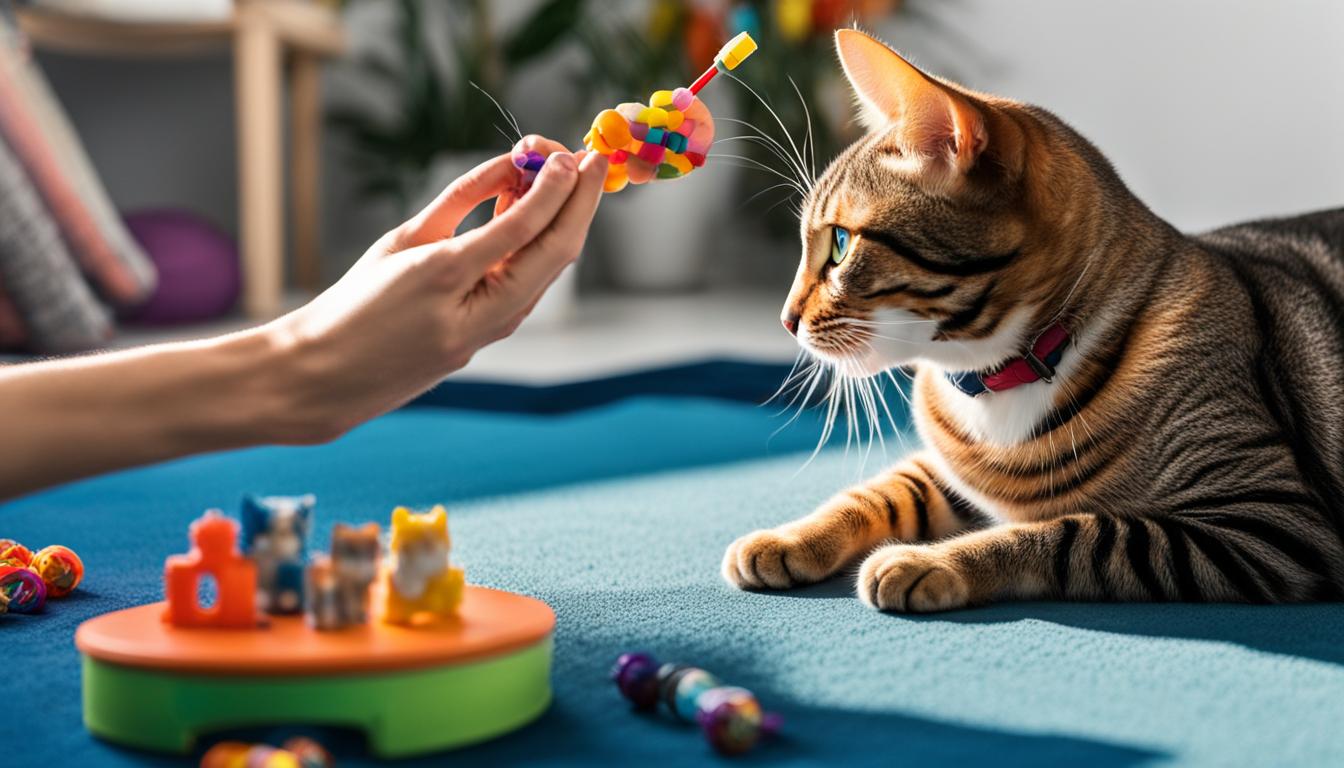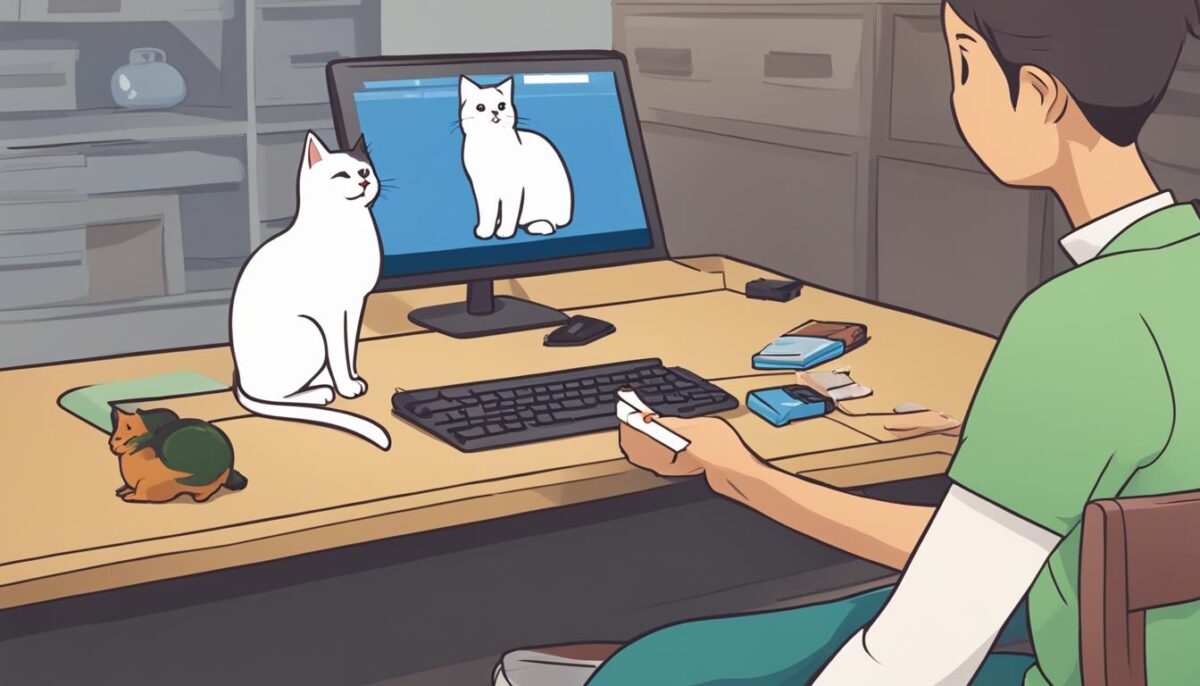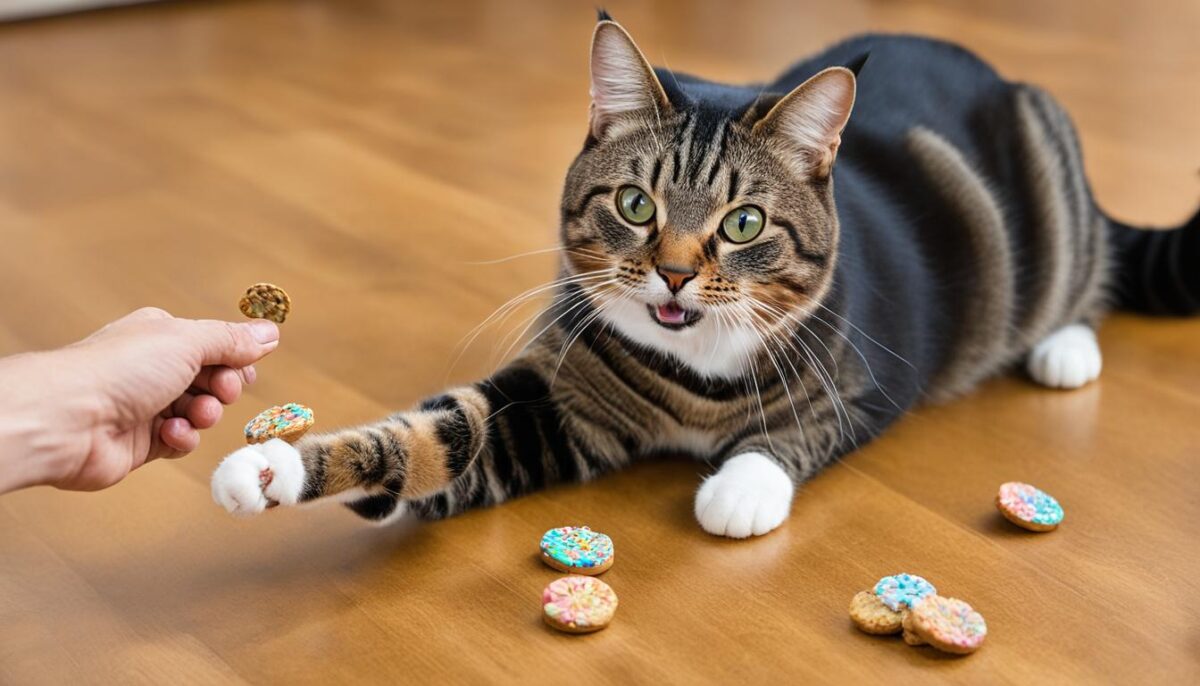Hey there! Want to teach your cat some cool tricks and improve how they listen to you? You can do all that with clicker training for cats. It’s a fun way to help your cat learn new things. All you need is a little clicker, which is a small thing that makes a sound when you press it. When your cat does something you like, you click and give them a yummy treat. This way, they know that the sound means they did a good job!
Don’t worry if your cat seems scared of the noise at first. There are ways to make the sound quieter so they can get used to it. Plus, you can use your voice instead if you don’t have a clicker. Just say “Yes” in a special way every time they do something good. This kind of training isn’t just for tricks; it’s great for any cat behavior training. It makes you and your cat better friends and gives them a happy and busy mind.
Key Takeaways
- Clicker training is fun and helps cats learn.
- A clicker makes a sound to tell your cat they’re doing great.
- If your cat doesn’t like the sound, you can make it softer.
- You can also use your voice to say “Yes” as a click.
- Teaching your cat this way makes you both happier.
- It’s not just for tricks; it’s good for any cat obedience skills.
Understanding the Basics of Clicker Training for Cats
Clicker training is a way to teach your cat to do cat desirable behavior by using positive reinforcement training. What does this mean? It means when your cat does something good, you give them a treat so they know they did well. It’s like saying “Good job!” with a tasty snack!
You may wonder about the clicker training basics. It all starts with a small tool called a clicker. When your cat does the right thing, you click and then give them a treat. You have to click at the same time your cat does what you want. This helps your kitty understand what they did to earn their treat!
It’s not just about the click though. There’s more to it! Let’s talk about the clicker training tools. One tool you can use is a target stick. It’s a stick that you can point with, so your cat knows where to go or what to touch. It makes learning new things easier and more fun for your kitty.
Remember, treats are very important in clicker training. Some treats are extra tasty, and your cat will work hard to get them. These are called high-value treats, and you use them for the hard stuff you’re teaching. But even with yummy treats, we only want to practice for about 5 minutes at a time. Cats can get bored or tired if we try to do too much.
We can teach kittens and older cats too! It’s all about helping them learn new things and having fun at the same time.
Adjusting your cat’s meal times can make training even better. Cats love to eat, and they will want to learn when they know a treat is coming. So, if you feed your cat a little less at mealtime, they might be more excited to get treats when they learn with the clicker.
Here’s a table that shows a few things we use for clicker training, how we use them, and why they’re important:
| Tool | How to Use | Why It’s Important |
|---|---|---|
| Clicker | Press the clicker every time your cat does the right thing. | Hearing the clicker helps your cat understand exactly what they did to get a treat. |
| Target Stick | Point with the stick to guide your cat to move or touch something. | Your cat can move around without being touched, which they like better. |
| High-Value Treats | Use these treats when your cat does something more difficult. | They make your cat really want to learn harder tricks because they taste so good! |
And that’s how you get started with clicker training. You’re going to have so much fun teaching your cat and watching them learn new things. Remember, take it slow, use treats wisely, and always end on a happy note!
Prepping Your Kitty for Clicker Training Success
Getting your furry friend ready for training is super important. You want your kitty to have fun and learn fast. Let’s get started with finding the best snacks to make your cat excited and ready for learning!
Finding the Right Treats
Every kitty has their own favorite snacks. You know your cat loves treats, but did you know that some treats can make your cat want to learn more? High-value treats are super tasty and can help teach your cat cool tricks. If your kitty is not into the treats you have, they might be bored with them or just not hungry. Try giving them moist food at meal times and keep those dry goodies for training fun. This way, they will really want those cat training treats during their lessons!
Setting Up a Training Schedule
How often and how long you train your kitty can make a big difference in how well they learn. Keep training time short, about 5 minutes so they don’t get tired. Doing a few of these short cat training sessions every day, with breaks, is a great idea. Cats love routines and keeping training at the same times each day can help. This cat training consistency makes learning easier and helps to improve your cat’s behavior.
| Treat Type | Why It’s Good | Best for Learning… |
|---|---|---|
| Dry Treats | Easy to handle | Simple tricks |
| Moist Treats | Very tasty | Harder tricks |
| Homemade Goodies | Healthier choice | Any new behavior |
Remember, finding treats that your kitty likes is key to a happy and fun clicker training routine. Try different snacks to see what gets your cat moving. And, keeping lessons short but doing them often will help you and your kitty have a great time learning together!
Clicker Training for Cats
Learning clicker training steps can be like a fun game for you and your cat. It’s one of the cat training methods that helps your furry friend understand what you want. You’ll start simple, and then, step by step, teach more amazing tricks. It’s like following a training progression on a special path called a clicker training roadmap. And guess what? There’s a place called Cat School that has just the roadmap you need!
Here’s the deal: You don’t always need to give a treat after your cat does something right, but the clicker sound? That’s a must. It’s like saying “Good job!” to your cat every time. Always remember, making training fun and being super clear will make you both happy.
- Start with a simple trick, like ‘sit’. This is your beginning.
- Use the clicker and give a treat. This says “Yes, that’s right!”
- Teach one trick at a time. Your cat will like this more.
- Keep it short. Five minutes of training is a good start.
So, go ahead, begin this adventure with your cat. Click, treat, and repeat. You’ll be a great team, learning together step by step!
Advancing Your Cat’s Training and Tackling Common Challenges
Is your cat not too sure about the clicker? You can help them get over their clicker fear. Some cats find the sound a bit scary. You can fix this by making the noise quieter. How? You can wrap the clicker in a soft cloth. This makes its sound less loud. Then, slowly, you can make it louder as your cat gets used to it. This is called clicker sound adjustment. Soon, they will know that the clicker means good things, like treats! This is what we call making a positive clicker association.
If you have more than one furry friend, training can be even more fun! Training multiple cats or group cat training might sound tough, but it’s not. You can teach your cats one by one first. Then, bring them together and use a mat or chair for each cat. This way, each cat knows where to sit and wait for their turn. This helps you manage multiple pets at the same time.
Clickers are not just for teaching cool tricks. You can also use them to fix behaviors you don’t like. If your cat is doing something you want them to stop, like jumping on the counter, clicker training behavior correction can help. You teach them to do a different, good behavior instead. By using a clicker, you can quickly tell your cat, “Hey, this is what I like!” every time they do the right thing. This is called alternative behavior training.
Addressing the Fear of Clickers
If your kitty is nervous about the clicker, don’t worry! Start by using the clicker far away from them or make the clicker sound softer. Once your cat seems okay with that, use it like normal, but not too fast. Give lots of love and snacks when you click. This way, the clicker becomes a good thing, not scary!
Multiplying the Fun with Multiple Cats Training
Having a few cats? You can still teach them all at once. Use things like mats to show each cat where to go. This keeps everyone happy and not fighting for your attention. They can each have a spot which helps you teach them without getting mixed up.
Correct Behavioral Issues with Clicker Reinforcement
When your cat does something naughty, like scratching the couch, it’s time for some training. Clicker training can help you teach them what is okay to do instead. Every time they choose the right action, click and treat. They’ll learn that good choices bring them yummy rewards!
Conclusion
So, you and your cat have been working on clicker training, and guess what? You’ve been doing a great job! By teaching your kitty with clicks and treats, you’ve not only made learning fun but also helped create a stronger bond between the two of you. Remember how you could teach your cat to high-five? That’s not just cool, it helps your cat’s brain stay sharp. In fact, every little trick and obedience skill adds to mental stimulation for cats.
Clicker training is not just about following rules or doing tricks. It’s a way for you and your cat to understand each other better. The bond – that special friendship – you’re building with your kitty is priceless. When you train with a clicker, your cat learns to listen to you, and you learn more about what your cat likes. That’s a big win for both of you, right?
And let’s not forget, all the fun and learning also makes your cat’s life way more interesting. Think of it like this: Every click brings your kitty happiness and makes their day better. That’s the real magic of clicker training. The big benefits – like fixing habits that might be bothersome – are the cherry on top. What’s important is the happy, furry friend who loves spending time with you. That’s how clicker training benefits you and your cat, making life richer for both of you.
FAQ
What is clicker training for cats?
Clicker training for cats is a form of positive reinforcement training where a clicker is used to mark the exact moment a desirable behavior occurs. This sound is immediately followed by a treat, teaching your cat to associate the click with a reward. It’s an effective method for teaching obedience, tricks, and correcting behaviors.
How does clicker training improve cat behavior?
Clicker training improves cat behavior by providing instant positive reinforcement for desired actions, helping your cat understand what is being asked of them. By using clicker training, you encourage your cat to repeat those good behaviors, thereby improving overall obedience and discipline.
Can you use alternatives to a clicker in clicker training?
Yes, if a clicker isn’t available or your cat is fearful of the noise, you can use alternatives such as a specific word like “Yes,” or a click made with your mouth. It’s important to be consistent with whatever sound you choose to use as your marker.
What are the best treats to use for clicker training?
The best treats for clicker training are ones that your cat finds irresistible. High-value treats that are not part of their regular diet can be very motivating, especially for challenging tasks. It’s essential to determine your cat’s treat preferences and vary the treats to keep your cat interested in training.
How long should clicker training sessions last?
Clicker training sessions should be kept short, ideally around 5 minutes, to maintain your cat’s interest and prevent overstraining. Multiple short sessions throughout the day are preferable as they can help reinforce learning and maintain a keen focus on training.
What basic skills should I start with when clicker training my cat?
Start with simple skills such as ‘sit’ or ‘come’ and use target training to build a foundational understanding. Once your cat has mastered these basics, you can gradually move on to more complex tasks and tricks. This step-by-step approach ensures steady progression and success in learning.
How do I address my cat’s fear of the clicker sound?
If your cat is scared of the clicker sound, start by muffling the clicker or clicking from a distance. Pair the muffled sound with treats to create a positive association. Gradually acclimate your cat to the clicker noise by reducing the muffling as the cat becomes more comfortable.
Can I clicker train multiple cats at the same time?
Yes, it is possible to clicker train more than one cat simultaneously, but it requires individual attention and possibly managing each cat separately with mats or designated spaces. Using food puzzles or snuffle mats can keep the other cats engaged while you work with one cat at a time.
How can clicker training help correct undesired behaviors?
Clicker training can correct undesired behaviors by providing an alternative behavior to do instead. Once the new behavior is established, you reinforce it with the clicker and a treat. This positive reinforcement approach makes the new, preferred behavior more rewarding for your cat.
Why is clicker training beneficial for my cat’s mental health?
Clicker training provides mental stimulation by challenging your cat’s mind. It encourages them to think and make connections between actions and rewards. This form of engagement can help reduce boredom and associated negative behaviors, leading to a more content and happier cat.


